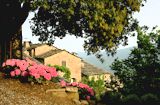I was about to start off like a newspaper reporter by saying that
Leonardo da Vinci's painting of Mona Lisa has fascinated the world for the past 400 years, but the truth is that the painting's notoriety is comparatively recent. After Leonardo's death in France in 1519, François I bought the painting and kept it at the Palace of Fontainebleau where it remained until it was given to Louis XIV, who moved it to the Palace of Versailles. After the French Revolution, it was displayed in the Louvre. During the mid-19th century, Théophile Gautier and the Romantic poets had much to say about Mona Lisa as a person and as a painting, but the picture really only began to achieve its current fame after World War I.
 |
| A comparison of the Louvre and Prado Mona Lisa portraits |
Although there a numerous copies of Leonardo's
Mona Lisa in existence, the cleaning during 2012 of the copy stored away in the
Prado Museum in Madrid has revealed a contemporary copy of great skill and beauty. Infrared reflectography images of the Prado painting show underdrawing similar to that of the Louvre
Mona Lisa before it was finished. This suggests that the original and the copy were begun at the same time and painted next to each other in the same studio. All the evidence currently points to either Andrea Salai, who joined Leonardo’s studio in 1490, or Francesco Melzi, who joined around 1506, as the painter. The Prado's curator favours Melzi.
Along with fame came numerous theories about who the subject of the
painting was, despite Vasari - who would have known - clearly stating
that she was Lisa Gherardini, a member of the Gherardini family of
Florence and wife of a wealthy Florentine silk merchant, Francesco del
Giocondo. Some scholars have proposed that Lisa Gherardini was the
subject of a different
portrait, especially since Vasari specifically comments on the beauty of
the eyebrows and eyelashes, of which the Louvre
Mona Lisa is
famously lacking. In any case, there's little doubt that Lisa Gherardini
is portrayed and that she was born in Florence and not at
Villa Vignamaggio in Chianti,
despite what the owner of that magnificent villa says, since the villa
was sold by the Gherardini family 58 years before her birth.
 |
| Excavating a skeleton purported to be that of Lisa Gherardini, Mona Lisa. |
This brings us to the current headline-generating antics of
Silvano Vinceti, an archaeological flibbertigibbet who, among other things, claimed to have found that bones of Caravaggio in an obscure cemetery crypt in Porto Ercole - by "pure coincidence", during the year of the 400th anniversary of Caravaggio’s death - and to have demonstrated that the model for the Mona Lisa was a man.
He seems to have forgotten this latter hypothesis, having somehow obtained permission to exhume the "remains of Mona Lisa" from among the hundreds of skeletons in a crypt of the former Convent of Saint Ursula (Convento di Sant’Orsola) in Florence. Lisa Gherardini retired to the convent after the death of her husband, herself passing away there at the age of 63. Just a few days ago, Vinceti exhumed remains, which he claims are those of Lisa Gherardini's sons, from the family tomb in the Martyrs' Crypt behind the altar of the Santissima Annunziata Basilica in Florence. All of this he proposes to confirm by DNA comparison between the different sets of bones and, perhaps, the very-much-alive Princesses Strozzi who are descendents of the Gherardini. The grand design behind all this digging and DNA blotting is to identify Lisa Gherardini's skull and to use the wildly unreliable forensic reconstruction technique to recreate her face and confirm or otherwise that Mona Lisa the person is Mona Lisa the painting. One thing we can be sure of, whatever Vinceti comes up with will be sensational, not least in its lack of verisimilitude!
 |
| Santissima Annunziata Basilica in Florence where the current excavations are in progress. |
|
Borgo di
Vagli restored mediaeval hamlet in Tuscany
|
 |
Borgo di Vagli has been authentically restored as
a Tuscan vacation hamlet. The residences can be bought in the form of
fractional ownerships, making a holiday home in Tuscany possible at
modest cost.
|
|
|
|
Fulvio Di Rosa
All content copyright © Fulvio Di Rosa 2013. All rights reserved.



